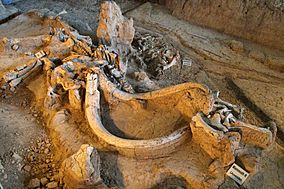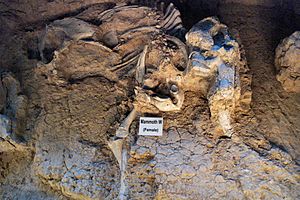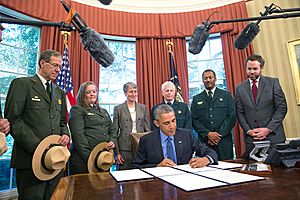Waco Mammoth National Monument facts for kids
Quick facts for kids Waco Mammoth National Monument |
|
|---|---|

Columbian mammoth bull and juvenile remains at the Waco Mammoth National Monument
|
|
| Location | Waco, Texas |
| Nearest city | Waco, Texas |
| Area | 5 acres (2.0 ha) |
| Created | July 10, 2015 |
| Visitors | 46,457 (in 2020) |
| Governing body | National Park Service, City of Waco, Baylor University |
| Website | Waco Mammoth National Monument |
| Designated: | July 10, 2015 |
The Waco Mammoth National Monument is a special place in Waco, Texas, United States. It's a paleontology site and museum where scientists have found fossils of 24 Columbian mammoths. These amazing animals lived during the Pleistocene Epoch, also known as the Ice Age.
This site is unique because it has the largest group of mammoths known to have died from a similar event. Scientists believe these mammoths were caught in powerful flash floods. The mammoths didn't all die at once. Instead, they died during three separate flood events in the same area.
After the first bone was found, a group of local partners worked together. The Waco Mammoth Foundation, the City of Waco, and Baylor University helped develop the site. Baylor University focused on researching, protecting, and storing the fossils. The City of Waco helped protect the land. In 2015, the site became a National Monument. This brought in the National Park Service to help manage and protect this important historical place.
Contents
Discovering Ancient Mammoths
What Were Columbian Mammoths Like?
Columbian mammoths were huge, hairy animals that lived between 10,000 and 1 million years ago. They traveled all over North America, even as far south as Nicaragua. These mammoths were herbivores, meaning they ate plants. Their diet included many different plants, from grasses to pine trees.
During the time these mammoths lived, Central Texas had wide, open grasslands and savannahs. These areas were surrounded by river floodplains.
How Did the Mammoths Die?
Scientists are still learning exactly how the animals at the Waco site died. There is no sign that humans were involved. The main idea is that about 68,000 years ago, a group of at least 19 mammoths, mostly mothers and their babies, got trapped. They were in a steep-sided river channel when a flash flood hit. They likely drowned or were buried by thick mud. A camel also died during this flood. Later floods covered their remains even deeper.
A second event happened sometime after the first. During this time, another animal died along with a young saber-toothed cat. The third event involved a large male mammoth, two young mammoths, and an adult female. About 15,000 years after the first group, these animals also seem to have been victims of rising water. They couldn't escape the slippery slopes of the river channel.
Scientists used a method called luminescence dating to figure out how old the fossils are. This method looks at the soil around the bones. It helps them know when the soil was last exposed to sunlight. Since the soil and mammoths were buried at the same time, this tells us when the mammoths died.
The First Discovery
The site was found in 1978 by two teenagers, Paul Barron and Eddie Bufkin. They were looking for arrowheads and fossils on a farm near the Bosque River. They found a very large bone. At first, they thought it was from a cow. But after digging it out, they saw it was 3 feet long – much too big for a cow!
They took the bone to the Strecker Museum at Baylor University. Experts there identified it as a Columbian mammoth bone. The museum then started a formal dig at the site. This excavation lasted from 1978 to 1990. In 1979, a Baylor student named George F. Naryshkin began working on the site. He spent two and a half years excavating and studying the area.
George got permission from the landowners to dig. He named the site "The Waco Mammoth Site." He uncovered five mammoths and wrote about his findings in 1980. After he graduated, 16 more mammoths were found. The first bones were carefully protected and stored at the Strecker Museum (now the Mayborn Museum Complex). Other remains, including a large male, a female, two young mammoths, and a Western Camel, were found later. These are still in their original spots at the site.
Even though the first bones were found in 1978, the site didn't open to the public until 2009. That year, a special shelter was built to protect the bones. This shelter also allowed visitors to see the fossils. Today, the site is managed by the City of Waco, Baylor University, and the National Park Service. It sits within 100 acres of beautiful wooded parkland along the Bosque River.
Becoming a National Monument
In 2010, United States Representative Chet Edwards tried to make the site a National Monument. This would have made it part of the National Park Service. The bill passed in the House of Representatives but did not pass in the Senate. Another Representative, Bill Flores, tried again in 2012 with a similar bill. It also passed the House but not the Senate.
Finally, on July 10, 2015, President Barack Obama used his special power under the Antiquities Act. He officially named the site the Waco Mammoth National Monument. It is now managed by the National Park Service, working with the City of Waco and Baylor University. President Obama signed the official papers in the Oval Office, surrounded by important officials. The city gave the 5-acre dig site to the federal government. However, it still owns 100 acres around it for future park plans.
What You Can See at the Monument
Geography of the Site
The Waco Mammoth National Monument is located in Waco, Texas. It is right next to the Bosque River, surrounded by 100 acres of wooded parkland. Scientists believe that being so close to the river is why the prehistoric animals died there. Flash floods likely drowned them about 67,000 years ago. Over time, soil and dirt covered the mammoths and other animals, preserving them deep in the earth.
Main Attractions
The Waco Mammoth National Monument is famous for having the only known remains of a herd of Columbian Mammoths that died together. You can also see fossils of a camel, a large male mammoth, and female mammoths. These fossils are "in situ", which means they are still in the exact spot where they were first found. This monument is one of the largest sites in the world where a single herd of animals died from natural causes.
Youth Activities: Become a Junior Ranger!
The National Monument offers fun ways for young people to get involved. You can go on field trips or group tours. You can even become a "Junior Ranger"! By completing activities throughout the park, you can take an oath and become an official Waco Mammoth National Monument Junior Ranger. It's a great way to learn about science and history.
More to Explore
- List of national monuments of the United States
- Natural history museums in Texas
- Paleontology in Texas
- La Brea tar pits
- List of mammoths
- The Mammoth Site





